In this article, you will learn What is Bearing? Classification and Types of Bearing in details.
Table of Contents
What is Bearing?
The word bearing is derived from the bear, which means to support or carry.
When there is a relative motion between two parts and if one part supports the other, the supporting part is known as a bearing.
Thus, a bearing is a mechanical element of a machine part which supports another mechanical element or part which is in relative motion with it.
The relative motion may be either linear or rotary.
As in the case of engine crosshead and guides, the guides act as bearings and relative motion is linear. Similarly, the ways of milling machines and planar machines can be treated as bearings.
As in the cases of spindles of a lathe, drilling and boring machines, axles of automobiles, crankshafts, etc., the relative motion between these and bearing is rotary.
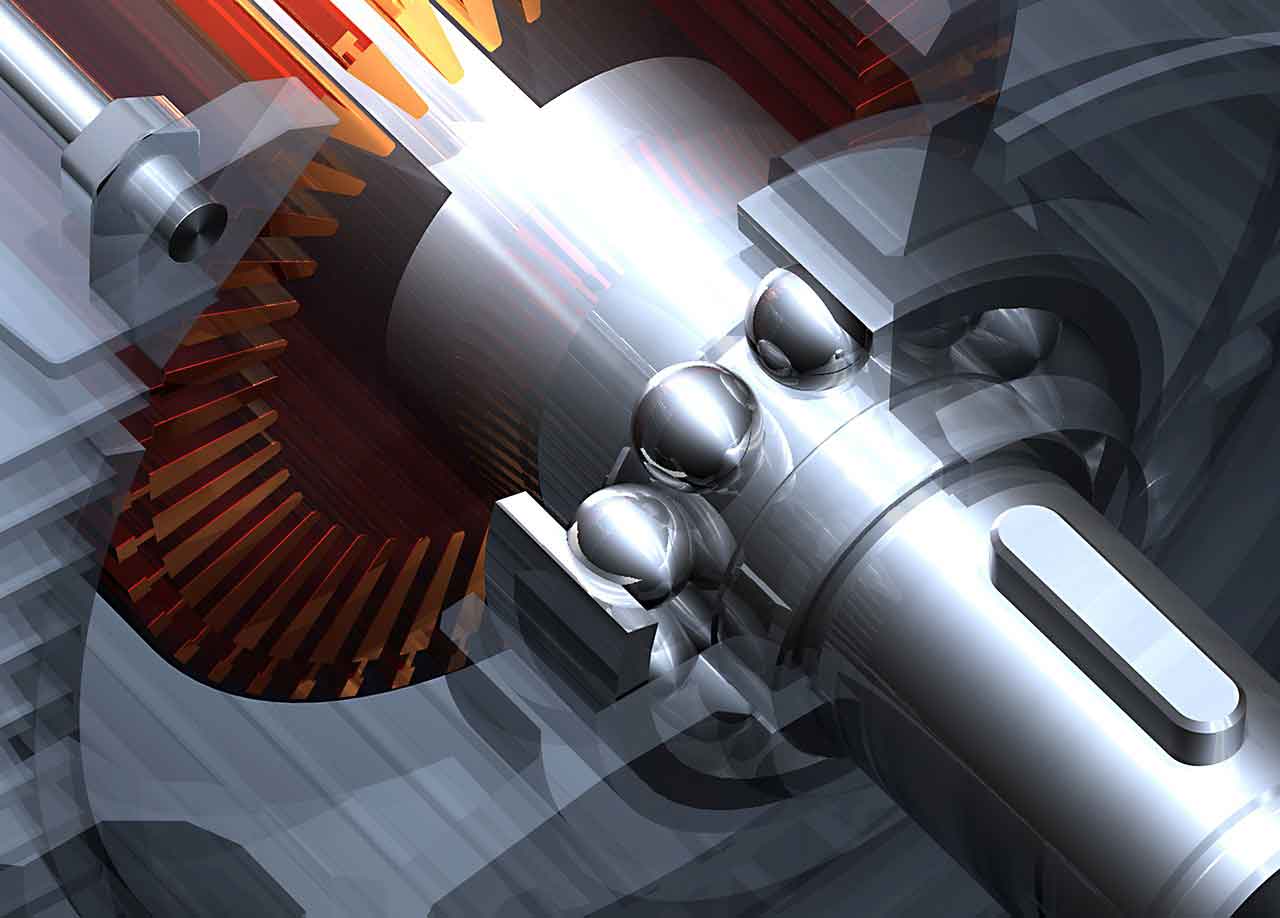
Need for Bearings.
In almost all types of machinery, either motion or power has to be transmitted through the rotating shafts, which in turn are held by the bearings.
These bearings allow the free and smooth rotation of shafts with minimum friction. The loss of power or motion can be minimized with suitable lubrication of bearing surfaces.
The necessity or need of the bearings is for the following two purposes.
1. To provide support to rotating shafts.
2. To allow free and smooth rotation of shafts.
3. To bear thrust and radial loads.
Types of Bearing.
Generally, the bearings can be classified into two types as follows:
1. Sliding contact bearings and;
2. Rolling contact bearings or anti-friction bearings.
1. Sliding Contact Bearings;
Sliding contact bearings and shafts have relative motion due to their sliding with respect to each other. In general, all the bearings which don’t use rollers and balls can be termed as sliding contact bearings.
Sliding Contacts Bearings are further divided into the following types.
i. Right Line or Guide Bearing;
If the direction of relative motion and the sliding of the surfaces are parallel, the bearing is known as the right line or guide bearing e.g., guides on engine cross heads, ways of milling machines and spindles of drilling and boring machines.
ii. Radial or Journal Bearing;
If the relative motion between shaft and bearing is rotary and if the load acts perpendicular to the axis of the shaft or along the radius of the shaft, the bearing is known as journal bearing or radial bearing.
The portion of the shaft enclosed by the bearing is known as journal.
iii. Thrust Bearing;
If the load on the bearing is parallel to the axis of the shaft, the bearing is known as a thrust bearing.
iv. Foot Step or Pivot Bearing;
In thrust bearing, if the end of the shaft terminates by resting on the bearing surface vertically, it is known as footstep bearing or pivot bearing.
v. Collar Bearing;
In thrust bearing, if ends of shaft extend beyond and through the bearing surface, it is known as collar bearing. The axis of the shaft remains horizontal.
vi. Bushed Bearing;
A simple type of bushed bearing is shown in ##Fig. 1.8 below. It consists of a cast iron body and a bush made of brass or gunmetal.
The body has a rectangular base. The base is made hollow to minimize the machining surface area. Two elliptical holes are provided at the base for bolting the bearing.
An oil hole is provided at the top of the body which runs through the bush. Thus, lubrication can be done for shaft and bush through the oil hole.
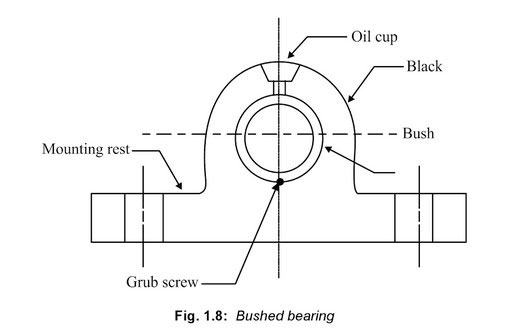
The inside diameter of the bush is equal to the shaft diameter. The bush is fixed imposition by a grub screw so that its rotation or sliding along with shaft is prevented.
If bush gets wear out, it is replaced by a new one. The shaft can be inserted into the bearing end-wise only. This is one disadvantage of this bearing.
Bushed bearing finds application in light loads and low speeds.
vii. Pedestal Bearing;
Pedestal bearing is popularly known as Plummer block. It is also called a split or divided journal bearing.
It consists of a cast-iron block called pedestal, a cast iron cap, gunmetal brasses in two halves, two mild steel square-headed blots and two sets of hexagonal lock nuts as shown in the ##Fig. 1.9 below.
The bearing is split type; it is made into two halves.
The top part is called cap, which is fastened to the main body called pedestal by means of square-headed bolts and hexagonal nuts.
This splitting or dividing of bearing facilitates easy placing and removal of the shaft as well as halves of the split bush.
The split bushes are known as brasses or steps.
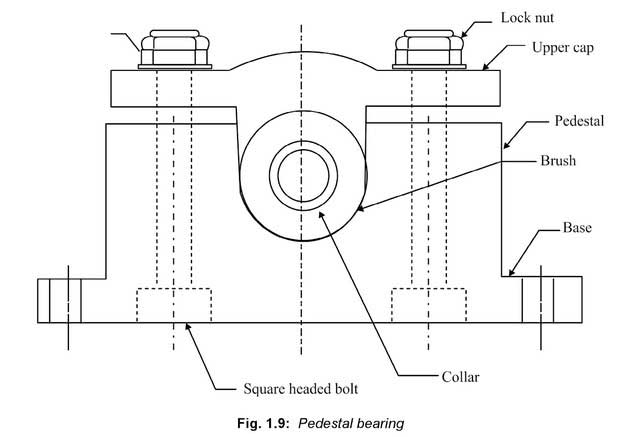
A snug is provided in a lower split bush which fits into the hole provided in the body.
So that the rotation of bush is prevented along with the shaft, and the axial movement is prevented by means of collar flanges on the ends.
The split bush material is brass, bronze, white metal, etc.
The shaft rests over the lower split bush. The upper split bush is placed over the shaft, and finally, the cap is tightened.
A small clearance is left between cap and body which helps when the cap is lowered due to rescuing of the bush with new linings.
This bearing finds its application in high speed and varying directions of the load.
viii. Footstep bearing or Pivot bearing.
In footstep or pivot bearing, the pressure acts parallel to the axis of the shaft and shaft rests in the bearing on its one end.
It consists of a cast-iron vertical circular block or body with a rectangular base and a gunmetal bush, as shown in the ##Fig. 1.10 below.
The block has open end through which the shaft is inserted. The shaft rests vertically on a steel disc having a concave scating.
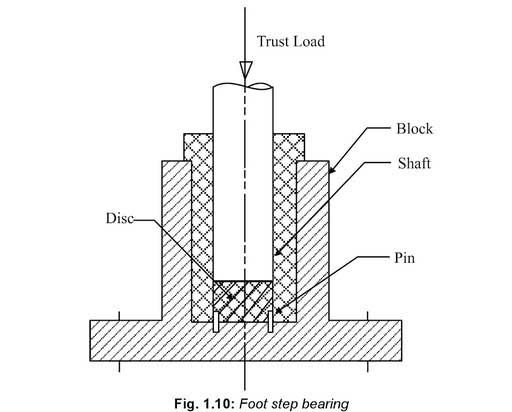
The disc is prevented from rotation along with the shaft by mean of a pin which is half inserted into disc and body.
The rotation of bush along with the shaft is prevented by means of snug provided at its neck just below the collar.
These bearings find applications in the machinery of textiles, paper, etc., used for light loads and low speeds.
In footstep bearing, lubrication is difficult as the oil is thrown out outwards from the center by centrifugal force.
2. Rolling Contact Bearings or Anti-friction Bearings.
In rolling contact bearings, the relative motion between the shaft and bearing is caused due to the rolling of balls and rollers used in the bearings.
Therefore these are called as rolling contact bearings or ball and roller bearings.
The bearing friction is much less than in sliding contact bearings, and there is less abrasion of machinery which require often starting and stopping under load.
Therefore, these bearings are called as anti-friction bearings.
There are two types of anti-friction bearings, and they are;
1. Ball bearings and;
2. Roller bearing.
i. Ball Bearings;
Spherical balls are used in ball bearings.
There are two types of ball bearings;
(i) Radial ball bearings and (ii) Thrust ball bearings.
Radial ball bearings are used for carrying the radial loads or the loads perpendicular to the axis of the shafts, while the thrust bearings are used for the thrust loads, i.e., loads acting parallel to the axis of the shaft.
Thrust ball bearings are used to carry thrust loads on the shafts.
They consist of hardened steel balls placed between two races. The races are grooved hardened steel rings. One race rotates along with the shaft, and another is fixed in the bearing housing.
The balls are maintained in position by means of cages. The cages are separators of the balls made up of pressed brass.
The arrangement of simple thrust bearing is shown in ##Fig. 1.11 below. The thrust ball bearings are used up to the speed of 2000 rpm.
For higher speeds of thrust loads, angular contact ball bearings are used. Under high speed, the balls are forced out of the races due to centrifugal force developed in the thrust bearings.
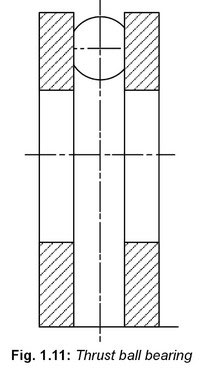
ii. Roller Bearings;
The roller bearings can be classified as radial roller bearings and thrust roller bearings. Radial and thrust roller bearings carry radial and thrust loads respectively.
Both these bearings can be further classified on the basis of types of rollers used, such as cylindrical roller bearings, needle roller bearings, and tapered roller bearings.
When compared to ball bearings, the roller bearings develop more friction but have a greater load capacity. For light load applications, ball bearings are used whose maintenance is less than that of same size roller bearings.
However, if the load is relatively heavy and the bearings are liable to be shock loaded, only the roller bearings are used.
Advantages and disadvantages of the ball and roller bearings;
When compared to sliding contact bearings, rolling contact bearings have the following advantages and disadvantages.
Advantages.
1. The starting and running friction is low.
2. Replacement is easy.
3. Can be used for both radial and axial loads.
4. Lubrication is simple.
5. Maintenance cost is low.
Disadvantages.
1. High initial cost.
2. Difficult to notice the occurrence of bearing failure.
3. High precision machining is required for bearing housing.
Please, don’t forget to share it. Sharing is Caring :)-
Read Also: What is Flat Belt Drive? | Its Advantages and Disadvantages.
Thanks this site is very good and I got many think of study from this site
Thanks this site is very good and I got many think of study from this site and perparing to for good job thanx again